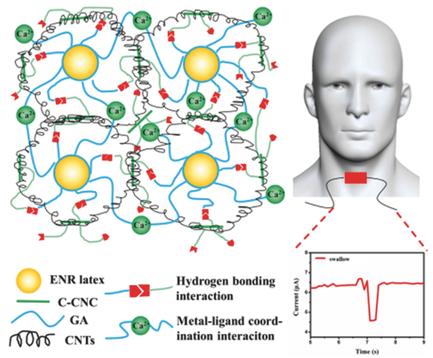当前位置:
X-MOL 学术
›
Macromol. Rapid Commun.
›
论文详情
Our official English website, www.x-mol.net, welcomes your feedback! (Note: you will need to create a separate account there.)
Self‐Healing Sensors Based on Dual Noncovalent Network Elastomer for Human Motion Monitoring
Macromolecular Rapid Communications ( IF 4.6 ) Pub Date : 2017-10-30 , DOI: 10.1002/marc.201700406 Jie Cao 1 , Xu Zhang 1 , Canhui Lu 1 , Yongyue Luo 2 , Xinxing Zhang 1
Macromolecular Rapid Communications ( IF 4.6 ) Pub Date : 2017-10-30 , DOI: 10.1002/marc.201700406 Jie Cao 1 , Xu Zhang 1 , Canhui Lu 1 , Yongyue Luo 2 , Xinxing Zhang 1
Affiliation

|
Nowadays, it is still a challenge to prepare flexible sensors with great mechanical strength, stretchability, high sensitivities, and excellent self‐healing (SH) abilities. Herein, a nanostructured supramolecular elastomer is reported with a dual noncovalent network of hydrogen bonding interactions and metal–ligand coordination. The resultant flexible sensor presents ultrafast (30 s), autonomous, and repeatable SH ability with high healing efficiency (80% after the 3rd healing process), as well as enhanced mechanical properties. Benefitting from the 3D conductive network, the sensor exhibits high electrical sensitivity and very low detection limit (0.2% strain). As a result, the flexible sensor is capable of precisely monitoring small strains of human motions (such as vocal‐cord vibration), and exhibits reproducible and recognizable current signals after cutting–healing process. The dual noncovalent network design proposed here opens up a new opportunity for scalable fabrication of high performance SH sensors and other electronic devices.
中文翻译:

基于双非共价网络弹性体的自愈传感器,用于人体运动监测
如今,制备具有出色机械强度,可拉伸性,高灵敏度和出色的自愈(SH)能力的柔性传感器仍然是一个挑战。本文报道了一种纳米结构的超分子弹性体,具有氢键相互作用和金属-配体配位的双重非共价网络。所得的柔性传感器具有超快的(30 s),自主的和可重复的SH功能,具有很高的治愈效率(第三次治愈后为80%),并具有增强的机械性能。得益于3D导电网络,该传感器具有很高的电灵敏度和非常低的检测极限(0.2%应变)。结果,该柔性传感器能够精确监视人体的微小应变(例如声带振动),并在切割修复过程后展现出可重现和可识别的电流信号。这里提出的双重非共价网络设计为高性能SH传感器和其他电子设备的可扩展制造开辟了新的机遇。
更新日期:2017-10-30
中文翻译:

基于双非共价网络弹性体的自愈传感器,用于人体运动监测
如今,制备具有出色机械强度,可拉伸性,高灵敏度和出色的自愈(SH)能力的柔性传感器仍然是一个挑战。本文报道了一种纳米结构的超分子弹性体,具有氢键相互作用和金属-配体配位的双重非共价网络。所得的柔性传感器具有超快的(30 s),自主的和可重复的SH功能,具有很高的治愈效率(第三次治愈后为80%),并具有增强的机械性能。得益于3D导电网络,该传感器具有很高的电灵敏度和非常低的检测极限(0.2%应变)。结果,该柔性传感器能够精确监视人体的微小应变(例如声带振动),并在切割修复过程后展现出可重现和可识别的电流信号。这里提出的双重非共价网络设计为高性能SH传感器和其他电子设备的可扩展制造开辟了新的机遇。


























 京公网安备 11010802027423号
京公网安备 11010802027423号